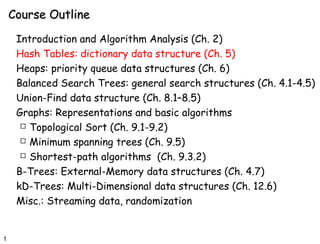The document outlines various data structures and algorithms for implementing dictionaries and hash tables, including:
- Separate chaining, which handles collisions by storing elements that hash to the same value in a linked list. Find, insert, and delete take average time of O(1).
- Open addressing techniques like linear probing and quadratic probing, which handle collisions by probing to alternate locations until an empty slot is found. These have faster search but slower inserts and deletes.
- Double hashing, which uses a second hash function to determine probe distances when collisions occur, reducing clustering compared to linear probing.





![6
Another Naïve Method: Direct MappingAnother Naïve Method: Direct Mapping
Maintain an array (bit
vector) for all possible
keys
insert (i): set A[i] = 1
find (i): return A[i]
remove (i): set A[i] = 0
Student Records
1
2
3
8
9
13
14
Graduates
Perm #](https://image.slidesharecdn.com/4-150507102306-lva1-app6892/85/4-4-hashing02-6-320.jpg)
![7
Another Naïve Method: Direct MappingAnother Naïve Method: Direct Mapping
Maintain an array (bit vector) for all possible keys
insert (i): set A[i] = 1
find (i): return A[i]
remove (i): set A[i] = 0
All operations easy and fast O(1)
What’s the drawback?
Too much memory/space, and wasteful!
The space of all possible IP addresses, variable names in a
compiler is enormous!](https://image.slidesharecdn.com/4-150507102306-lva1-app6892/85/4-4-hashing02-7-320.jpg)








![16
Maintain a list of all elements that
hash to the same value
Search using the hash function to
determine which list to traverse
Insert/deletion–once the “bucket”
is found through Hash, insert and
delete are list operations
Separate chainingSeparate chaining
class HashTable {
……
private:
unsigned int Hsize;
List<E,K> *TheList;
……
find(k,e)
HashVal = Hash(k,Hsize);
if (TheList[HashVal].Search(k,e))
then return true;
else return false;
14
42
29
20
1
36
5623
16
24
31
17
7
0
1
2
3
4
5
6
7
8
9
10](https://image.slidesharecdn.com/4-150507102306-lva1-app6892/85/4-4-hashing02-16-320.jpg)





![22
// find the slot where searched item should be in
int HashTable<E,K>::hSearch(const K& k) const
{
int HashVal = k % D;
int j = HashVal;
do {// don’t search past the first empty slot (insert should put it there)
if (empty[j] || ht[j] == k) return j;
j = (j + 1) % D;
} while (j != HashVal);
return j; // no empty slot and no match either, give up
}
bool HashTable<E,K>::find(const K& k, E& e) const
{
int b = hSearch(k);
if (empty[b] || ht[b] != k) return false;
e = ht[b];
return true;
}
Search with linear probingSearch with linear probing](https://image.slidesharecdn.com/4-150507102306-lva1-app6892/85/4-4-hashing02-22-320.jpg)


![25
remove(j)
{ i = j;
empty[i] = true;
i = (i + 1) % D; // candidate for swapping
while ((not empty[i]) and i!=j) {
r = Hash(ht[i]); // where should it go without collision?
// can we still find it based on the rehashing strategy?
if not ((j<r<=i) or (i<j<r) or (r<=i<j))
then break; // yes find it from rehashing, swap
i = (i + 1) % D; // no, cannot find it from rehashing
}
if (i!=j and not empty[i])
then {
ht[j] = ht[i];
remove(i);
}
}
Eager Deletion: fill holesEager Deletion: fill holes
Remove and find replacement:
Fill in the hole for later searches](https://image.slidesharecdn.com/4-150507102306-lva1-app6892/85/4-4-hashing02-25-320.jpg)

















![43
Theory of Hashing: Universal Hash FunctionsTheory of Hashing: Universal Hash Functions
AA setset of hash functions H is called universal if for any hashof hash functions H is called universal if for any hash
function h chosen randomly from itfunction h chosen randomly from it
Prob[h(x) = h(y)]Prob[h(x) = h(y)] <=<= 1/M, for any x, y in U1/M, for any x, y in U
TheoremTheorem.. Suppose H is universal, S is an n-element subset ofSuppose H is universal, S is an n-element subset of
U, and h a random hash function from H.U, and h a random hash function from H.
The expected number of collisions is at most (n-1)/M forThe expected number of collisions is at most (n-1)/M for
any x in S.any x in S.](https://image.slidesharecdn.com/4-150507102306-lva1-app6892/85/4-4-hashing02-43-320.jpg)







![51
Perfect Hashing: Worst-Case O(1) LookupPerfect Hashing: Worst-Case O(1) Lookup
Universal hashing assures us that hashing has expected O(1)Universal hashing assures us that hashing has expected O(1)
search time, assuming n/M is at most a constant.search time, assuming n/M is at most a constant.
But what about worst case?But what about worst case?
There remains a small, but non-zero, prob. of unlucky randomThere remains a small, but non-zero, prob. of unlucky random
draw.draw.
A more sophisticated theory of Perfect Hashing shows thatA more sophisticated theory of Perfect Hashing shows that
one can even achieve O(1) worst-case result, using a 2-levelone can even achieve O(1) worst-case result, using a 2-level
hashing table.hashing table.
Fredman-Komlos-Szemeredi [JACM 1984]Fredman-Komlos-Szemeredi [JACM 1984]](https://image.slidesharecdn.com/4-150507102306-lva1-app6892/85/4-4-hashing02-51-320.jpg)








![60
Bloom Filters; DetailsBloom Filters; Details
A bloom filter is a bit vector B of m bitsA bloom filter is a bit vector B of m bits
Each key is mapped to B using k independent hash functionsEach key is mapped to B using k independent hash functions
The number of hash functions k is an optimization parameterThe number of hash functions k is an optimization parameter
To insert x into STo insert x into S
Compute hCompute h11(x), h(x), h22(x), …, h(x), …, hkk(x)(x)
Set B[hSet B[hii(x) = 1], for i=1,2,…, k.(x) = 1], for i=1,2,…, k.
To check for membership:To check for membership:
Compute hCompute h11(x), h(x), h22(x), …, h(x), …, hkk(x)(x)
Answer Yes ifAnswer Yes if B[hB[hii(x) = 1], for all i=1,2,…, k.(x) = 1], for all i=1,2,…, k.
Otherwise answer No.Otherwise answer No.](https://image.slidesharecdn.com/4-150507102306-lva1-app6892/85/4-4-hashing02-60-320.jpg)





